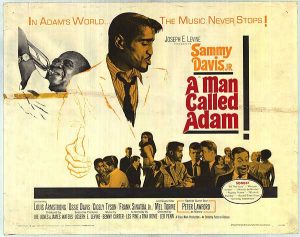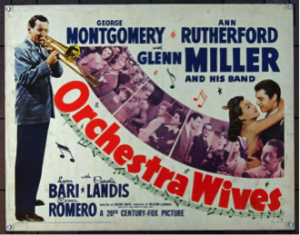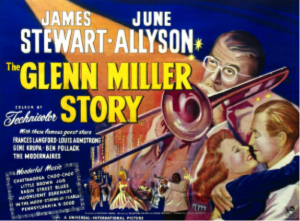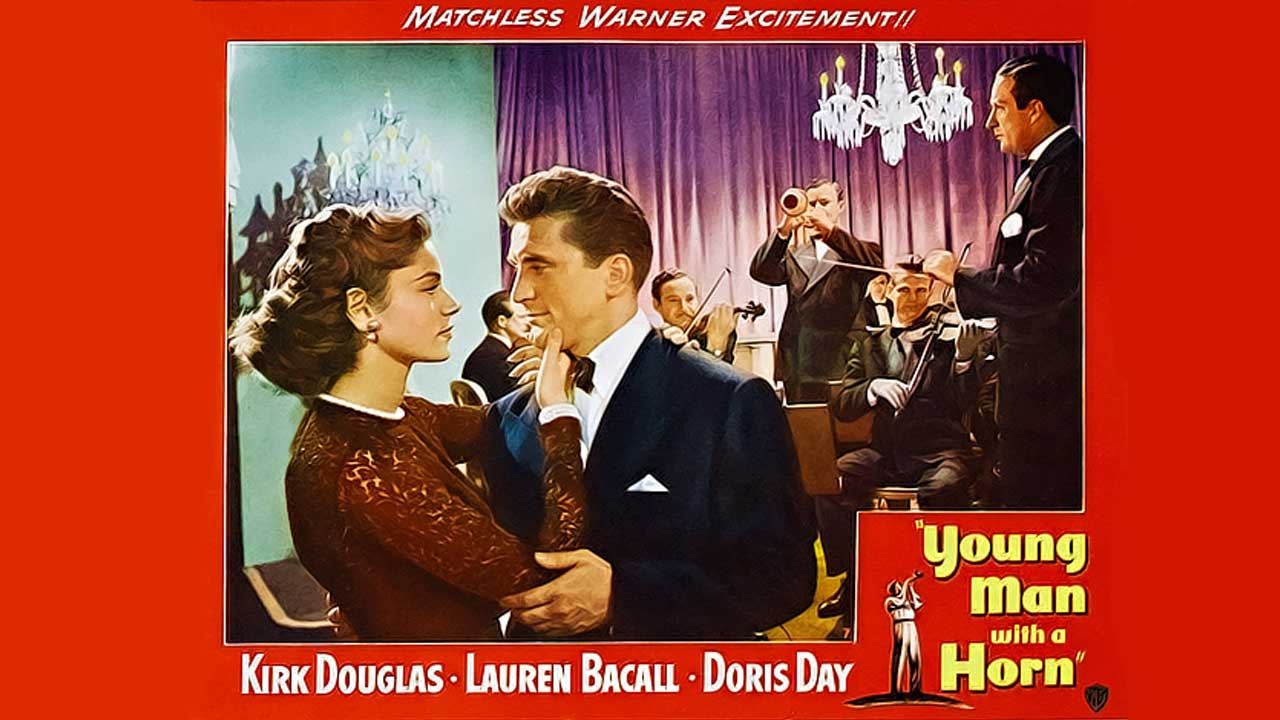
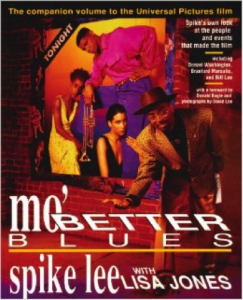 Director Spike Lee’s 1990 homage to jazz, scored by his father, bassist Bill Lee (the last Spike Lee film on which the director’s father served as music director as they had a bitter falling out after this film). Denzil Washington plays the sexy, self-absorbed trumpet player Bleek and Lee plays his gambling addicted manager, Giant. Good scenes of the egotistical dynamics of a professional jazz band. Bleek gets smashed in the mouth (a la Chet Baker) and cannot play anymore but is ultimately redeemed by his family. Many Jews disliked Lee’s portrayal of Jewish jazz club owners, which does indeed border on stereotype. But what is Spike Lee without controversy?
Director Spike Lee’s 1990 homage to jazz, scored by his father, bassist Bill Lee (the last Spike Lee film on which the director’s father served as music director as they had a bitter falling out after this film). Denzil Washington plays the sexy, self-absorbed trumpet player Bleek and Lee plays his gambling addicted manager, Giant. Good scenes of the egotistical dynamics of a professional jazz band. Bleek gets smashed in the mouth (a la Chet Baker) and cannot play anymore but is ultimately redeemed by his family. Many Jews disliked Lee’s portrayal of Jewish jazz club owners, which does indeed border on stereotype. But what is Spike Lee without controversy?
Sammy Davis, Jr.’s most important dramatic film, also starring Cicely Tyson (Miles Davis’s girlfriend at the time the film was made), Louis Armstrong (in his best dramatic role, by far, much more powerful and less stereotyped than his role as Shadow Johnson in the 1952 film, Glory Alley), Ossie Davis, and Frank Sinatra, Jr. Clearly inspired by the life and temperament of Miles Davis, (trumpet solos in the film were done by Nat Adderley), this 1966 film, directed by Leo Penn (father of Sean), was quite talked-about when it was released, particularly in its controversial depiction of the relationship between Sammy Davis, Jr. and his manager, played by Peter Lawford. Typical tragic downfall of the superlative but alienating artist, it is a film that deserves more attention. Says much about race, jazz, and civil rights in the 1960s.
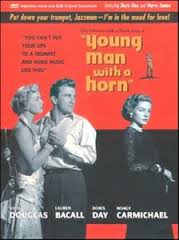 This 1950 film version of Dorothy Baker’s 1938 novel (inspired by the life of the
This 1950 film version of Dorothy Baker’s 1938 novel (inspired by the life of the
great white jazz cornetist Bix Beiderbecke) stars Kirk Douglas as, you guessed it, another egotistical, self-absorbed trumpeter who learned from a black but neglected jazz trumpeter named Art Hazzard, (a name that says it all), played Juano Hernandez. The relationship between Hernandez and Douglas is a typical American trope, a standard reworking of Huck and Jim on the raft where the old black guy teaches the young white protege. Also starring Doris Day and Lauren Becall, this Hollywood melodramatic stew will make you think twice about having your daughter mess around with a white jazz musician.
George Montgomery plays a trumpeter in Glenn Miller’s band (featuring the real Glenn Miller band) and Ann Rutherford, fresh from the arms of Mickey Rooney’s Andy Hardy, as the love interest. This 1942 Archie Mayo film is actually one of the more enjoyable Hollywood jazz films. Glenn Miller and Tex Benecke are passable actors. Caesar Romero is always fun. The film is a fairly realistic depiction of life in a swing band. Look for a young Jackie Gleason complaining like Ralph Kramden and swinging that bass.
5. The Five Pennies
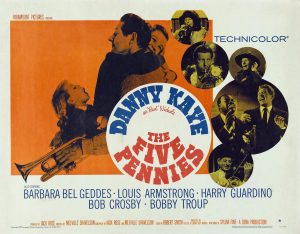 Danny Kaye plays cornetist Loring Red Nichols in this 1959 biopic with plenty of Dixieland and a lot of angst about parenting. Nichols played all the solos himself in this standard Hollywood musical film. Louis Armstrong is also in the film, which is a great boon. I cannot think of any movie in which Armstrong appeared where he did not considerably improve the neighborhood.
Danny Kaye plays cornetist Loring Red Nichols in this 1959 biopic with plenty of Dixieland and a lot of angst about parenting. Nichols played all the solos himself in this standard Hollywood musical film. Louis Armstrong is also in the film, which is a great boon. I cannot think of any movie in which Armstrong appeared where he did not considerably improve the neighborhood.
And 15 Other Notable Films About Jazz
- The Rat Race
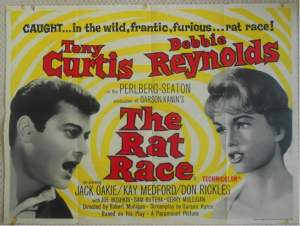 I saw this movie when I was 8 years old and it knocked my socks off. Nothing could be finer than to be a jazz musician living platonically in a New York apartment with someone who looked like Debbie Reynolds. Tony Curtis plays a saxophonist from the sticks (Milwaukee) who loves Dave Brubeck and Debbie Reynolds is a cynical dancer trying to hold on to maiden honor in hard, cruel New York City in this 1960 Robert Mulligan film. Don Rickles is something between a pimp, a racketeer, and a suppressed comic who wants to insult people.
I saw this movie when I was 8 years old and it knocked my socks off. Nothing could be finer than to be a jazz musician living platonically in a New York apartment with someone who looked like Debbie Reynolds. Tony Curtis plays a saxophonist from the sticks (Milwaukee) who loves Dave Brubeck and Debbie Reynolds is a cynical dancer trying to hold on to maiden honor in hard, cruel New York City in this 1960 Robert Mulligan film. Don Rickles is something between a pimp, a racketeer, and a suppressed comic who wants to insult people.
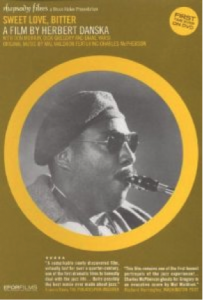 This 1967 film is an adaptation of John A. Williams’s 1961 novel, Nightsong, about a self-destructive, angry saxophonist named Eagle. All references to jazzman Charlie “Yardbird” Parker are coincidentally intentional and obvious. St. Louis’s own Dick Gregory plays Eagle, who apparently is done in by racism and a philistine American capitalism that does not appreciate art or genius, and Don Murray plays a white hanger-on who has nearly as many emotional problems as Eagle and hardly seems any sort of support for him. Robert Hooks plays an Eagle admirer who runs a chili joint. There are hints and suggestions of interracial sex (or interracial sexual yearning here) that is not only never consummated but never even mutually expressed. Of course, why make a jazz movie of this gritty sort that lacks the courage of its convictions when it comes to interracial sex when half the people hanging around jazz clubs in those days were looking for (and getting) exactly that? Director Herbert Danska said the original version got mangled in the cutting room. (Maybe the more graphic bits about miscegenation also hit the floor.) The film was shot in Philadelphia which, considering that players like Byard Lancaster, the Heath brothers, Lee Morgan, McCoy Tyner, Archie Shepp, and others came from there and John Coltrane lived there for more than ten years, seems like a good place to shoot. But the version of the film I saw was so dark I could not tell where the actors were. Good jazz soundtrack by pianist Mal Waldron. But where is Louis Armstrong when you need him to leaven this soggy mess of a movie?
This 1967 film is an adaptation of John A. Williams’s 1961 novel, Nightsong, about a self-destructive, angry saxophonist named Eagle. All references to jazzman Charlie “Yardbird” Parker are coincidentally intentional and obvious. St. Louis’s own Dick Gregory plays Eagle, who apparently is done in by racism and a philistine American capitalism that does not appreciate art or genius, and Don Murray plays a white hanger-on who has nearly as many emotional problems as Eagle and hardly seems any sort of support for him. Robert Hooks plays an Eagle admirer who runs a chili joint. There are hints and suggestions of interracial sex (or interracial sexual yearning here) that is not only never consummated but never even mutually expressed. Of course, why make a jazz movie of this gritty sort that lacks the courage of its convictions when it comes to interracial sex when half the people hanging around jazz clubs in those days were looking for (and getting) exactly that? Director Herbert Danska said the original version got mangled in the cutting room. (Maybe the more graphic bits about miscegenation also hit the floor.) The film was shot in Philadelphia which, considering that players like Byard Lancaster, the Heath brothers, Lee Morgan, McCoy Tyner, Archie Shepp, and others came from there and John Coltrane lived there for more than ten years, seems like a good place to shoot. But the version of the film I saw was so dark I could not tell where the actors were. Good jazz soundtrack by pianist Mal Waldron. But where is Louis Armstrong when you need him to leaven this soggy mess of a movie?
Burt Lancaster plays a powerful gossip columnist and Tony Curtis plays the groveling, hustling publicist Sidney Falco, one of his most memorable roles, in this gem of a film, directed by Alexander Mackendrick and produced by Lancaster’s own production company. Released in 1957, it features Martin Milner as a jazz guitarist who is courting Lancaster’s sister. Lancaster is having none of it. (Nobody wants a female relative to marry a jazz musician.) The jazz band featured in the film to which Milner belongs is West Coast drummer Chico Hamilton’s quintet, a cool jazz unit of the day that was not only racially integrated but featured a cello as one of the lead instruments. All the players in the band are the actual musicians in Hamilton’s band except Milner, who replaces guitarist Jim Hall. A couple of nice scenes with Hamilton and the other players with some nice jazz interludes.
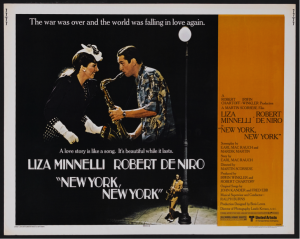 Director Martin Scorsese’s 1977 homage to big band jazz and the highly stylized, artificial American musical was not commercially or critically successful, and its failure nearly killed him. Robert De Niro plays the most unlikeable, most lousy and self-absorbed jazz musician in the history of American cinema. (And that is saying something, as American cinema has more than a few really self-absorbed and unpleasant male jazz representations.) Liza Minnelli is the girl singer who becomes his lover and wife and endures his callous treatment. There are some nice jazz moments in the film. But where is Louis Armstrong when you need him?
Director Martin Scorsese’s 1977 homage to big band jazz and the highly stylized, artificial American musical was not commercially or critically successful, and its failure nearly killed him. Robert De Niro plays the most unlikeable, most lousy and self-absorbed jazz musician in the history of American cinema. (And that is saying something, as American cinema has more than a few really self-absorbed and unpleasant male jazz representations.) Liza Minnelli is the girl singer who becomes his lover and wife and endures his callous treatment. There are some nice jazz moments in the film. But where is Louis Armstrong when you need him?
James Stewart plays Miller; June Allyson plays his wife. Nuff said! If Allyson is playing anyone’s wife, you know how this film is going to go: a lot of sweetness and light with a deft touch of momentary anguish. This 1954 film, directed by Anthony Mann, has a few nice moments about the trombonist band leader, but the plot is standard Hollywood biopic fare.
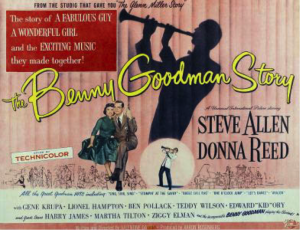 Any resemblance between this and the real clarinetist Benny Goodman is purely coincidental! Actually, the film, more or less, provides the bare outlines of Goodman’s life without any of the famed jazz musician’s true personality. Steve Allen, a composer and musician in his own right, plays Goodman as if he were Clark Kent and Donna Reed plays his wife as if she is in search of a family sitcom in this 1956 film, directed by Valentine Davies, who wrote the screenplay for The Glenn Miller Story which was nominated, oddly, for an Oscar. One interesting thing to note here: Sammy Davis, Sr., father of Sammy Davis, Jr., plays black bandleader and composer Fletcher Henderson, who, in real life, supplied arrangements for the Goodman band. Actually, you can see the real Goodman on film to much better effect in the 1944 Archie Mayo film, Sweet and Low-Down, where Goodman plays himself. This film, like Orchestra Wives, is a pretty decent account of life in a jazz band. The real Goodman does a comic turn in the 1948 film, A Song is Born, starring Danny Kaye. A Song is Born is a remake of the 1941 film, Ball of Fire, starring Gary Cooper and Barbara Stanwyck, both directed by Howard Hawks. Although not as good as the original, A Song is Born features some great jazz musicians including saxophonist Charlie Barnet, pianist Mel Powell, vibe player Lionel Hampton, and Louis Armstrong as well as Goodman.
Any resemblance between this and the real clarinetist Benny Goodman is purely coincidental! Actually, the film, more or less, provides the bare outlines of Goodman’s life without any of the famed jazz musician’s true personality. Steve Allen, a composer and musician in his own right, plays Goodman as if he were Clark Kent and Donna Reed plays his wife as if she is in search of a family sitcom in this 1956 film, directed by Valentine Davies, who wrote the screenplay for The Glenn Miller Story which was nominated, oddly, for an Oscar. One interesting thing to note here: Sammy Davis, Sr., father of Sammy Davis, Jr., plays black bandleader and composer Fletcher Henderson, who, in real life, supplied arrangements for the Goodman band. Actually, you can see the real Goodman on film to much better effect in the 1944 Archie Mayo film, Sweet and Low-Down, where Goodman plays himself. This film, like Orchestra Wives, is a pretty decent account of life in a jazz band. The real Goodman does a comic turn in the 1948 film, A Song is Born, starring Danny Kaye. A Song is Born is a remake of the 1941 film, Ball of Fire, starring Gary Cooper and Barbara Stanwyck, both directed by Howard Hawks. Although not as good as the original, A Song is Born features some great jazz musicians including saxophonist Charlie Barnet, pianist Mel Powell, vibe player Lionel Hampton, and Louis Armstrong as well as Goodman.
12. The Strip 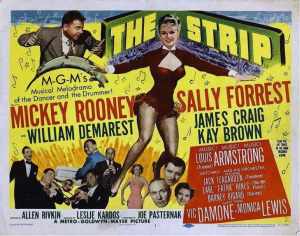
This minor, mediocre 1951 mystery with film noir-ish effects, directed by László Kardos, features Mickey Rooney as a jazz drummer—about as convincing as Sal Mineo in The Gene Krupa Story and Frank Sinatra in The Man With the Golden Arm, who also played drummers—who gets mixed with a cold-hearted dame and tough gangsters running nightclubs and bookie joints (Are there any other kind of bad guys in films like this?) I guess actors are told that if they flail their arms energetically and look impishly possessed during a solo, they can pass as jazz drummers. I have seen this film several times, but the details of the plot stubbornly resist being remembered. But Rooney’s character gets the good girl in the end and the bad girl gets her just desserts. How could the movie end any other way! Once again, the viewer is treated to Louis Armstrong who is joined by trombonist Jack Teagarden, pianist Earl Hines, and clarinetist Barney Bigard in some very nice jazz interludes arranged by Pete Ruggolo. “A Kiss to Build a Dream Upon” is from this film, although it was not expressly written for it, and was nominated for an Oscar and everyone in the film, whether he or she was capable of singing, gets a chance to warble this tune.
13. Paris Blues
 Martin Ritt’s 1961 jazz film that stars Sidney Poitier as a saxophonist and Paul Newman as a trombonist. Poitier winds up romancing Diahann Carroll and Newman is paired with Joanne Woodward when the film would have been far more interesting and gutsy had Poitier paired with Woodward and Newman coupled with Carroll which it seemed to hint at initially. Otherwise, why have the cast go to Paris at all, if not to be liberated from American mores and taboos. They could easily have had intra-racial sex in the good old US of A. But Hollywood was not ready to do anything like that in 1961! Louis Armstrong plays Wild Man Moore, another one of these black men as the Holy Grail of jazz figures, but Armstrong is always great in any movie. The shots of the audience in the jazz sequences, all hip and beat, makes a viewer unsure whether Ritt is making fun of people who like jazz, or doing cinéma vérité.
Martin Ritt’s 1961 jazz film that stars Sidney Poitier as a saxophonist and Paul Newman as a trombonist. Poitier winds up romancing Diahann Carroll and Newman is paired with Joanne Woodward when the film would have been far more interesting and gutsy had Poitier paired with Woodward and Newman coupled with Carroll which it seemed to hint at initially. Otherwise, why have the cast go to Paris at all, if not to be liberated from American mores and taboos. They could easily have had intra-racial sex in the good old US of A. But Hollywood was not ready to do anything like that in 1961! Louis Armstrong plays Wild Man Moore, another one of these black men as the Holy Grail of jazz figures, but Armstrong is always great in any movie. The shots of the audience in the jazz sequences, all hip and beat, makes a viewer unsure whether Ritt is making fun of people who like jazz, or doing cinéma vérité.
14.The Gig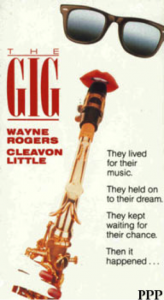
This 1985 Frank D. Gilroy film (writer and director) is about a white amateur jazz band that gets a professional job in the Catskills. When the band’s bassist falls ill, bandleader Wayne Rogers hires professional bassist Cleavon Little. This sweet little comedy neatly resolves the tensions between amateur and professional and between black and white in ways that are satisfying to the viewing audience. Cornetist Warren Vache plays one of the amateur musicians and displays good acting chops. A film that deserves more attention than it has received.
15. Round Midnight
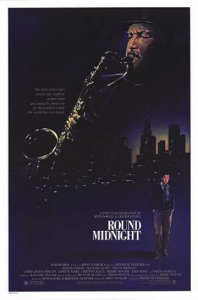 Saxophonist Dexter Gordon, who actually served time in Chino State Prison, shook off his heroin addiction to become a major figure in jazz, plays a character sort of like saxophonist Lester Young and sort of like pianist Bud Powell and sort of like himself in this offbeat Bertrand Tavernier film that offers its jazz, health, and race clichés leavened with a lot of good jazz performances in the film. Gordon was nominated for an Oscar as best actor in 1986.
Saxophonist Dexter Gordon, who actually served time in Chino State Prison, shook off his heroin addiction to become a major figure in jazz, plays a character sort of like saxophonist Lester Young and sort of like pianist Bud Powell and sort of like himself in this offbeat Bertrand Tavernier film that offers its jazz, health, and race clichés leavened with a lot of good jazz performances in the film. Gordon was nominated for an Oscar as best actor in 1986.
16. Bird
Clint Eastwood’s 1988 take on the most mythical and most hedonistic of all jazz musicians, saxophonist Charlie Parker, who lived fast and greedily and died young and grotesquely. Forrest Whittaker is good in the lead. The film offers a lot of good Parker music and makes white trumpeter Red Rodney a lot more significant in Parker’s life and music than he actually was. But then again, in Hollywood, when casting a black lead, better find a good white sidekick in order to get the financial backing to make the damned thing. Just ask Don Cheadle how that worked in
getting Miles Ahead made.
 Not to be confused with the 1944 Benny Goodman film (where low-down is hyphenated), Woody Allen’s 1999 “dramedy” about the second-best jazz guitarist in the whole wide world, Sean Penn, who, unfortunately, sounds like Django Reinhardt. Penn’s character is a minor success as a musician. He is egotistical, a womanizer, a self-absorbed mess who shoots rats in a garbage dump. He forms a relationship with a mute laundress, Hattie, but loses it, when he marries another woman on a whim. When he tries to reformulate his relationship with Hattie, he discovers that she has moved on with her life and married someone else. Penn’s character, while playing a melody that Hattie liked, smashes his guitar.
Not to be confused with the 1944 Benny Goodman film (where low-down is hyphenated), Woody Allen’s 1999 “dramedy” about the second-best jazz guitarist in the whole wide world, Sean Penn, who, unfortunately, sounds like Django Reinhardt. Penn’s character is a minor success as a musician. He is egotistical, a womanizer, a self-absorbed mess who shoots rats in a garbage dump. He forms a relationship with a mute laundress, Hattie, but loses it, when he marries another woman on a whim. When he tries to reformulate his relationship with Hattie, he discovers that she has moved on with her life and married someone else. Penn’s character, while playing a melody that Hattie liked, smashes his guitar.
18. Kansas City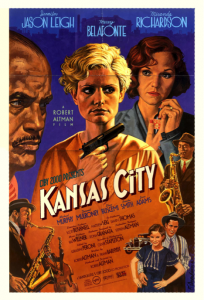
Robert Altman’s 1996 foray into 1930s jazz and crime with a good turn by Harry Belafonte as a gangster named Seldom Seen. Modern jazz musicians played their 1930s counterparts with stylized panache. Most critics consider it an interesting but flawed effort
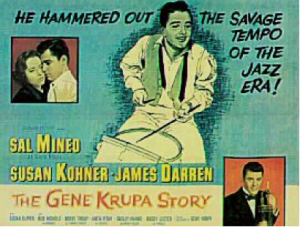 Sal Mineo plays the famous, frenetic Goodman drummer who was busted for marijuana possession in this 1959 biopic directed by Don Weis. Krupa dubs Mineo’s drum solos in a film that takes on the feel of being both a jazz biopic with the typical rise-fall-rise sequence and an alienated youth drama, the latter being the sort of fare Mineo specialized in at this time. Considering how linked jazz was at this time in the public mind with drug addiction, perhaps that combination of film sensibilities was a good thing.
Sal Mineo plays the famous, frenetic Goodman drummer who was busted for marijuana possession in this 1959 biopic directed by Don Weis. Krupa dubs Mineo’s drum solos in a film that takes on the feel of being both a jazz biopic with the typical rise-fall-rise sequence and an alienated youth drama, the latter being the sort of fare Mineo specialized in at this time. Considering how linked jazz was at this time in the public mind with drug addiction, perhaps that combination of film sensibilities was a good thing.
Although Sidney J. Furie is credited as director of this 1972 hot mess of a movie, everyone knows the real director was Motown mogul Berry Gordy who wanted to make Diana Ross, who plays jazz singer Billie Holiday in the film, a major film star. He nearly succeeded as Ross was nominated for a Best Actress Oscar. (She lost to Liza Minelli of Carbaret). What black folk liked about this film when it was released was that it showed a glamorous Hollywood romance between the two lead characters, played by Billie Dee Williams and Ross, more or less a first in American film. (Black publications referred to Williams as Clark Gable and Ross as, well, take your pick, Lana Turner, Myrna Loy, Claudette Colbert, Loretta Young, or whatever other white actress was famously paired with Gable on the screen.) What is most remembered about the film is that it brought comedian Richard Pryor (Piano Man) to the attention of the mainstream American audience and launched his film career. Billie Holiday records spiked in sales when the film was initially released and most black college students of the early 1970s thought it was hip to have at least one Billie Holiday album. I had 8, and was ahead of the curve, so to speak.
